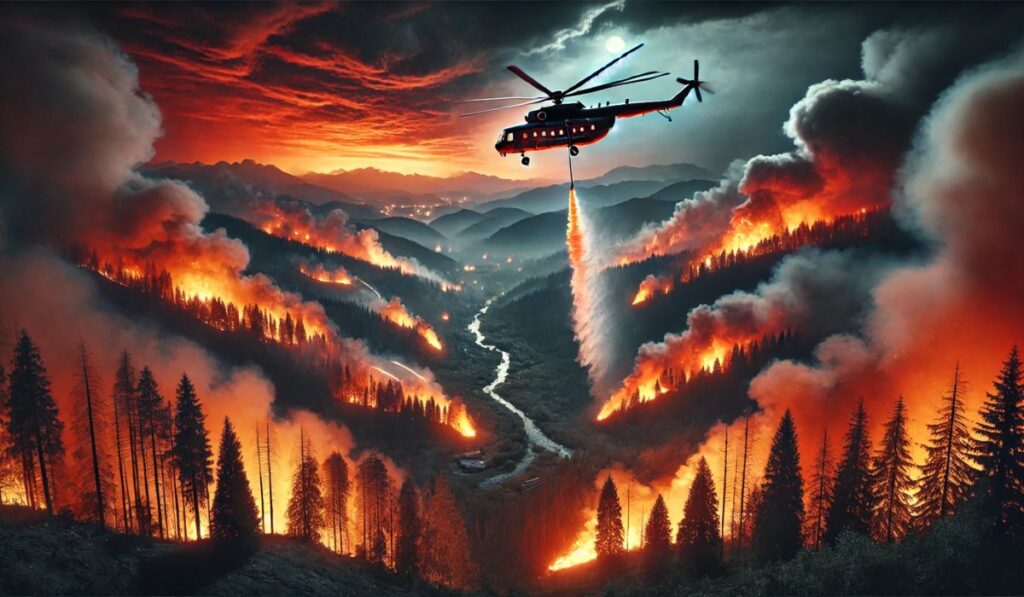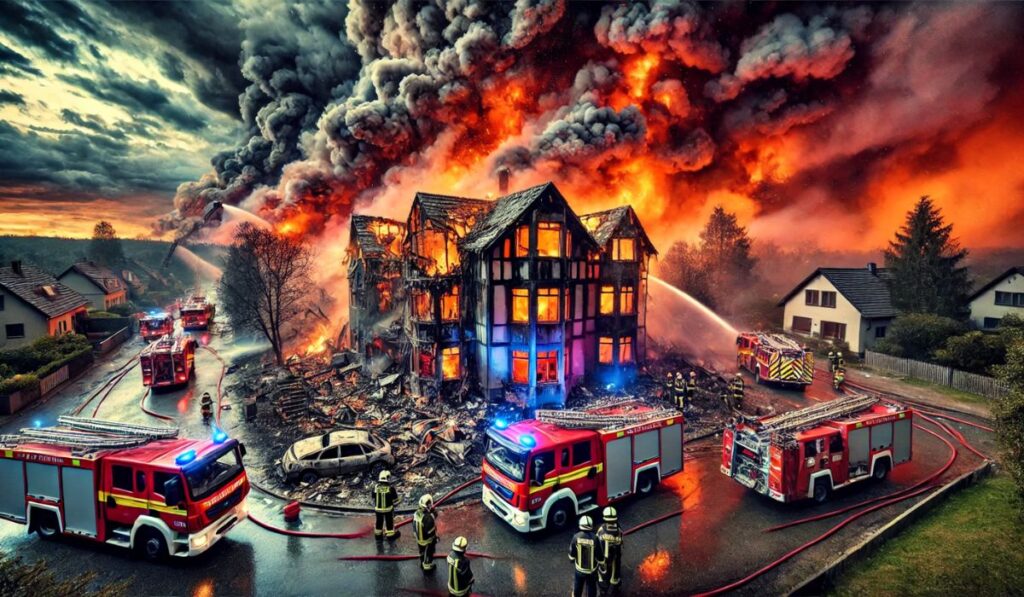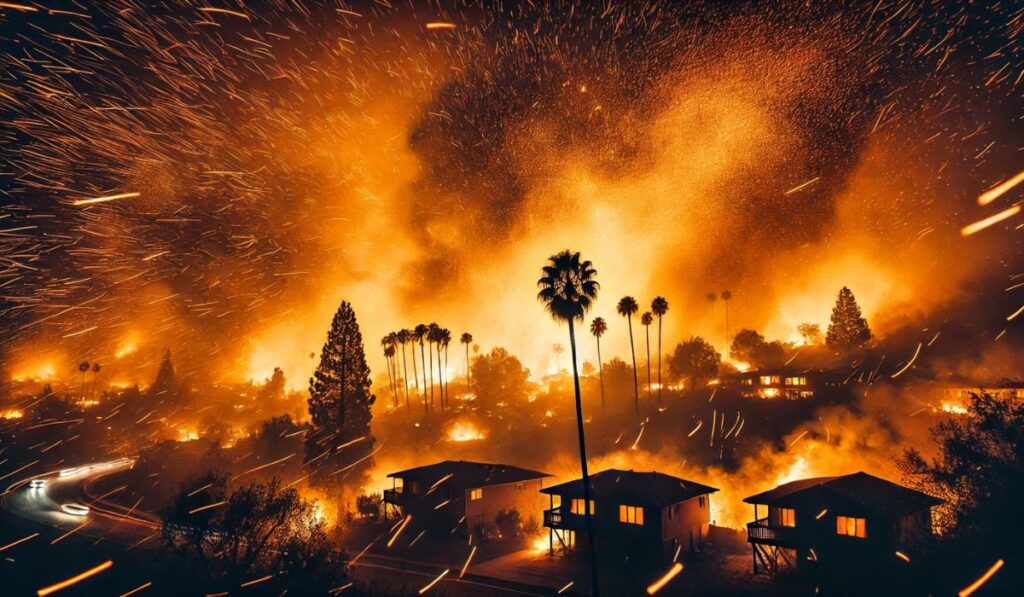Overview of the 2025 California Wildfires
In January 2025, wildfires started in Southern California and quickly spread to other areas. The fires burned through huge parts of Los Angeles, Ventura, and Santa Barbara counties, destroying homes and businesses. Strong winds and dry weather helped the fires spread fast. By mid-January, the fires were still burning, and many people were worried about what would happen next.
It is important to understand why these fires happened, what they caused, and how people are trying to stop them. The weather in California has gotten hotter and drier, which makes it easier for fires to start and spread. Sometimes, human actions like sparks from power lines or even people starting fires on purpose can make things worse. As the fires keep burning, experts are learning from them to help prevent fires in the future.
These wildfires hurt not just people but also the environment. Many families had to leave their homes, and some lost everything in the fires. The fires also hurt animals and plants, damaging their homes. The air became smoky and unsafe to breathe. California has had many fires before, but these were especially bad, and the state will need to find better ways to stop them in the future.
Background of the 2025 Wildfires
Timeline of the Wildfires
The 2025 California wildfires began on January 7. At first, the fires were small, but they quickly grew because of strong winds and dry weather. By January 9, the fires spread to bigger areas, putting homes in danger, especially in Southern California. Firefighters worked hard to stop the flames, but the hot, dry weather made it very hard to control the fires. As of mid-January, many fires were still burning, and thousands of people had to leave their homes.
Geographic Spread: Which Areas Were Most Affected?
Southern California was hit the hardest by the wildfires. Cities like Los Angeles, Malibu, and Santa Monica saw many homes and buildings destroyed. The fires also spread to nearby areas like Ventura and Santa Barbara, where farmers and small towns faced great losses. Some national parks and forests were also burned. People in these areas had to leave their homes as the fire spread quickly. The wildfires also affected parts of the coast and nearby highways, making travel dangerous.
Why California?
California is a place where wildfires happen often because of the weather. The state has dry summers and wet winters. In summer, the plants and grasses get dry, making them easier to catch fire. Winds can also make the fires spread very fast. Many homes are built near forests, grasslands, and parks, which makes it harder to keep fires away from neighborhoods. The land in California is also very different, with tall mountains and open spaces, which makes fighting fires even more challenging.
Overview of California’s Wildfire History
California has had many big wildfires over the years. In 2020, the state faced one of its worst wildfire seasons, with millions of acres burned. The 2025 wildfires are following this trend, burning more land and destroying more homes. Wildfires have always been a part of California’s natural environment, helping to clear dead plants and let new ones grow. But because more people now live in areas where wildfires happen, the damage from these fires is much worse.
Climate Conditions and Environmental Factors That Contribute to Fire Risk
California’s wildfires are getting worse because of climate change. When the weather gets hotter and drier, it makes fires more likely. The state also has long droughts, which means there is not enough rain to stop the plants from drying out. Strong winds make the fires spread faster. These changes in the climate make it harder for firefighters to control wildfires and for the environment to recover after a fire. Because of these conditions, the fires are bigger and harder to fight.
Key Causes of the 2025 Wildfires
Role of Weather Conditions
The weather in California made the 2025 wildfires worse. The region has been very dry for a long time, which made trees and plants easy to catch fire. Hot temperatures made the problem worse, as everything dried out even more. On top of that, strong winds pushed the flames quickly across large areas, making it harder for firefighters to stop them. These winds can carry burning embers far from the original fire, starting new ones in different places. As the weather gets hotter and drier, wildfires are likely to get worse in the future.
Human Factors and Ignition Sources
People can accidentally start fires, too. Many of the 2025 wildfires were possibly caused by things like broken power lines or electrical equipment. Sometimes, sparks from power lines can start a fire, especially when the grass and trees are dry. Other times, fires are started by people not being careful, like leaving campfires burning or tossing out cigarette butts. Investigators are working to figure out exactly what started the fires, and some people may have started fires on purpose, which is called arson. It’s important for everyone to be careful in areas where wildfires are common.
Climate Change and Fire Frequency
Climate change is making wildfires more common and more dangerous. As the planet warms up, California is getting hotter and drier. This means plants and trees are more likely to catch fire. The season for wildfires has also become longer. It used to be just in summer, but now fires can happen almost all year round. Because of climate change, we are seeing more extreme weather, like big storms and long droughts, which make wildfires even worse. If we don’t stop climate change, wildfires will likely keep happening and may get even worse.

Impact of the 2025 California Wildfires
Human Impact
Death toll and injuries: What is known so far?
The 2025 wildfires in California have caused many deaths and injuries. At least 16 people have died, and many more have been hurt. Some people were burned, while others had trouble breathing because of the smoke. Firefighters and other helpers are still trying to find missing people and help those who are hurt. As more areas are checked, the number of people affected might grow.
Displacement: Evacuations, shelters, and homelessness
Thousands of people had to leave their homes quickly because the fire spread fast. Many are staying in shelters for now, but they lost their homes. These families have nowhere to live, and it could take a long time for them to rebuild. Some people are struggling to find new places to stay. The shelters and helpers are doing their best, but the need for food, water, and housing is huge.
First responders and their role in managing the crisis
Firefighters, police, and rescue teams are working hard to save people and put out the fires. They are risking their own lives to help others. Even though they have been doing their best, the fire was so big that it overwhelmed them at times. More help from different parts of the country and better tools are needed to deal with fires like this in the future.
Economic Consequences
Destruction of property: Homes, businesses, and infrastructure
The 2025 wildfires destroyed many homes, stores, and roads. Whole neighborhoods in places like Los Angeles were burned down. Many people lost everything, including their homes and businesses. Public buildings, such as schools and hospitals, were also damaged. Rebuilding everything will take a lot of time and money.
Estimated financial losses: Insurance claims, rebuilding costs, etc.
The cost of the wildfires is very high. It could reach billions of dollars in damage. Many people are trying to get money back from their insurance, but some may not have enough coverage. Rebuilding homes, businesses, and roads will take even more money. The government may need to step in to help pay for repairs and provide support to people who lost everything.
Effects on tourism and local businesses
Tourism and local businesses in California have been hit hard by the fires. Popular places for tourists, like the beaches and parks, have been destroyed or closed. Many people who usually visit are staying away because of the smoke and damage. Local businesses, like restaurants and shops, have lost customers, and some have had to close for good. It will take time for the area to get back to normal and for visitors to return.
Environmental Impact
Loss of vegetation, wildlife, and ecosystems
The wildfires have burned many trees, plants, and animals’ homes. This has hurt the environment a lot. Animals, some of which are rare, have been killed or forced to leave their homes. It will take many years for plants and animals to recover, and some may never come back. The fires have caused big damage to the natural world.
Air quality and pollution: Smoke impact on local and global health
The smoke from the wildfires has made the air very unhealthy. People in California, and even in other states, have been breathing in dangerous air. This has caused problems for people with asthma or other breathing issues. The smoke also affects the climate, making the planet even hotter. The wildfires show just how serious pollution can be for both people and the planet.
Long-term environmental damage
The damage from the fires will last for a long time. Without trees and plants, the land can wash away when it rains, which leads to floods. The fires also make it harder for water to reach the ground and can cause water shortages in the future. Even though the fires may be over soon, the effects will last for years, and California will need to work hard to recover from this disaster.
Areas Most Affected by the 2025 California Wildfires
Los Angeles Metropolitan Area
The wildfires in January 2025 caused huge damage in the Los Angeles area. Many neighborhoods like Malibu, Pacific Palisades, and parts of Santa Monica were hit hard by the flames. Homes were burned down, and businesses were destroyed. The fire spread quickly because of strong winds, and firefighters had a tough time keeping up. The Palisades Fire was one of the biggest, burning a lot of land and leaving people with nothing but ashes.
Ventura and Santa Barbara Counties
The fires also reached the quieter, rural parts of California, like Ventura and Santa Barbara counties. Farms, ranches, and natural areas were burned, causing a lot of damage to the land. Many farmers had to leave their homes, and the fires hurt crops and animals. The Los Padres National Forest, which is full of trees and wildlife, was also affected. This caused a lot of harm to both the environment and the people who rely on the land for their living.
Other Notable Areas
In addition to cities and farms, the fires also reached important parks and protected lands. Areas like Channel Islands National Park and the Santa Monica Mountains were threatened by the flames. These places are important for wildlife and attract many visitors each year. The fires damaged the plants and animals that live there. It will take time and effort to fix the damage and help nature recover.
State and Federal Government Actions
When the 2025 California wildfires started, Governor Gavin Newsom quickly declared a state of emergency. This helped open up resources to fight the fires and help those affected. The state government worked with local agencies to set up emergency shelters and provide food, water, and medical care for people who had to leave their homes. The governor also worked with the federal government to get extra help. Together, they worked fast to give people the support they needed.
The Federal Emergency Management Agency (FEMA) also played a big part in helping with the fires. FEMA sent teams to help evacuate people and provide money for families and businesses that lost everything. FEMA worked with the U.S. Forest Service and other federal agencies to help fight the fires. They made sure that resources like food, water, and firefighting tools were available quickly to help stop the flames.
Firefighting Efforts
Fighting the wildfires in 2025 was very hard for firefighters. The fires spread quickly because of strong winds and dry weather. Firefighters used planes and helicopters to drop water and fire retardant on the flames from the air. On the ground, teams worked to stop the fire by cutting down trees and bushes to create firebreaks. Firefighters also made evacuation plans to get people out of dangerous areas before the fires reached them.
However, it wasn’t easy for firefighters. The winds were so strong that they made the fires spread faster than the teams could control. The heat was also intense, making it harder for the firefighters to keep working. There weren’t enough resources, like trucks and workers, to help everywhere. Firefighters had to choose which places needed the most help, which left other areas at risk.
Volunteer and Community Support
Along with the help from the government, many local people volunteered to help with the wildfires. Neighbors and local groups worked together to help evacuate families, bring supplies, and assist at emergency shelters. People also donated clothes, blankets, and other essentials to those who had lost their homes. Local organizations like the Red Cross helped to organize and distribute donations, making sure that everyone who needed help got it.
Communities came together to support each other in many ways. Some people raised money to help families rebuild their homes and businesses. Others opened their homes to offer temporary housing for those who lost everything. Social media was also used to connect people who needed help with those who could offer it. Everyone worked together to help each other through this difficult time.
The Role of Technology in Fighting Wildfires
Wildfire Detection and Early Warning Systems
Technology helps spot wildfires early and keep people safe. Satellites in space can see heat from fires and send information about where they are and how big they are. This helps firefighters know where to go quickly. Drones with special cameras can fly over the fire and take pictures to help firefighters plan their next steps. Also, smart computers use information about the weather and past fires to predict where the fire might go. This allows firefighters to warn people in danger and move resources to where they are needed most before the fire spreads.
Using technology this way helps save lives and protect homes. Early warning systems mean people have more time to leave dangerous areas. Firefighters can use the information to act faster and stop the fire from getting worse.
Firefighting Equipment
Firefighters have better tools and gear to fight fires today. New fire suits are made from special materials that protect against heat but are still light and easy to move in. These suits help keep firefighters safe when they get close to the flames. Firefighters also wear special gloves and boots that protect them from burns and heat. They use breathing masks that give them more air, so they can work longer in smoky areas without getting tired.
Fire trucks are also much stronger. They can carry more water and have powerful pumps that shoot water at high pressure to put out fires quickly. Firefighters now use helicopters and airplanes to drop water or special chemicals over big fires from the sky. These tools, along with information from satellites and drones, help firefighters work faster and safer to control the fire and protect people.

Impact on Local Communities
The 2025 California wildfires caused many families to lose their homes. People had to leave quickly, and many needed a place to stay. Shelters, hotels, and mobile homes were used to house those who lost everything. Groups like FEMA and the Red Cross helped with food, water, and money. Local people also helped, donating clothes and giving comfort during this tough time.
The emotional impact of the fires was huge. Many survivors felt sad, stressed, and scared after losing their homes. Some also lost family members. Mental health services were offered to help people feel better. Many survivors got support from counselors and local groups. First responders, like firefighters and doctors, also needed help to deal with the tough things they saw during the fires.
Rebuilding Infrastructure
Rebuilding the homes and buildings damaged by the fires is a big job. Many houses, schools, and businesses were destroyed. Local governments are working with builders to repair homes and make areas safe again. They are also fixing roads and services like water and electricity. Some businesses are reopening, giving jobs back to people who lost them.
Insurance companies and the government are helping fund the rebuilding. Many people are waiting for their insurance claims to be settled, but it’s a slow process. The state government is also giving money to rebuild important buildings, like schools and hospitals. It will take time, but these efforts will help people get back to their normal lives.
Environmental Restoration
The wildfires also hurt California’s forests and wildlife. Teams of experts are working to fix the damage. They are cleaning up trash, planting new trees, and protecting animals. This helps make sure that nature can heal and that people have clean air and healthy land.
Replanting trees is a big part of this recovery. The state has started projects to plant trees in the areas that burned the most. Many local groups and schools are helping with these projects. These new trees will help prevent future fires and make the land stronger. Fire prevention plans are also being updated, like creating safe spaces around forests and using controlled burns to keep the area safe.

